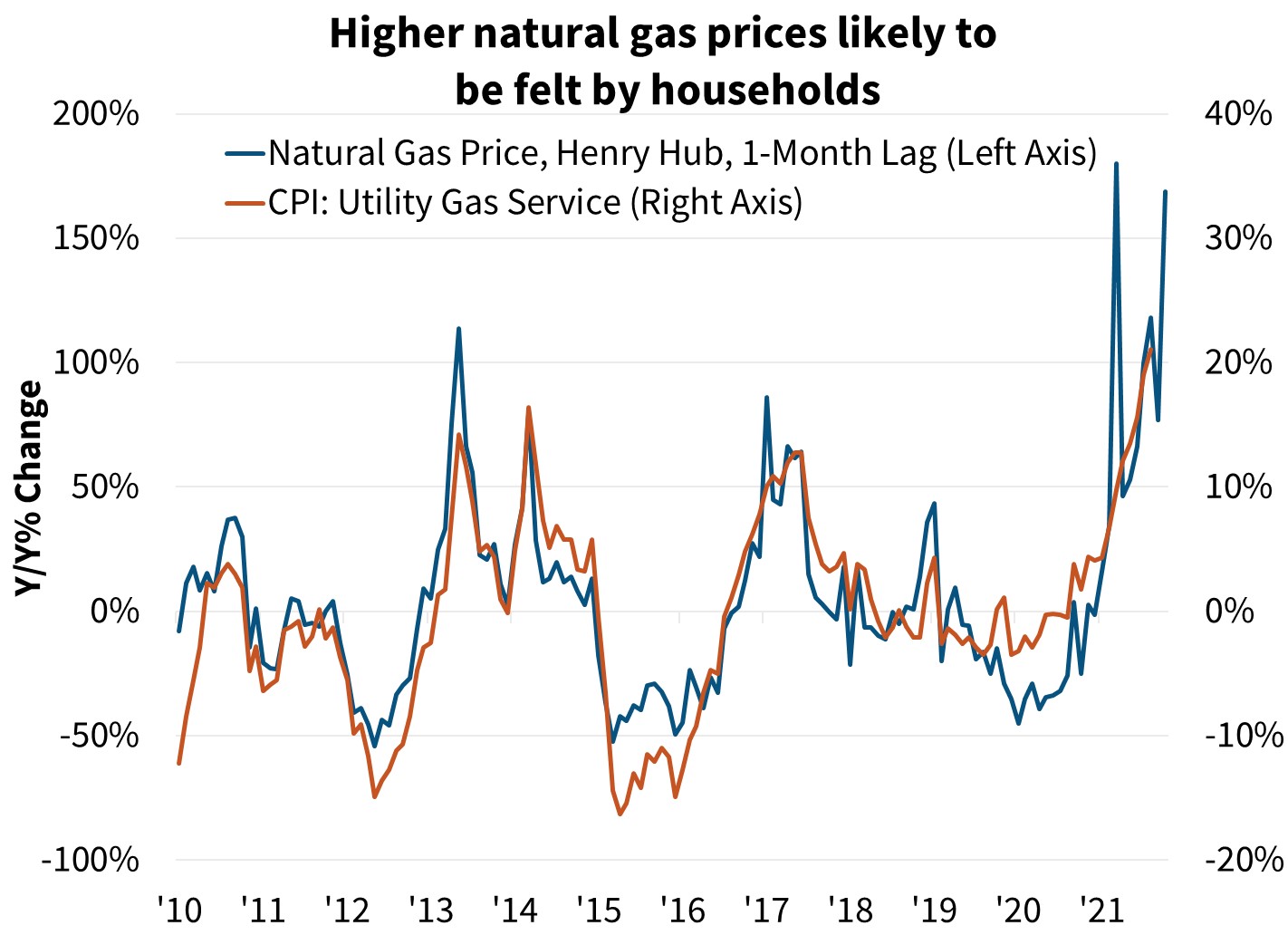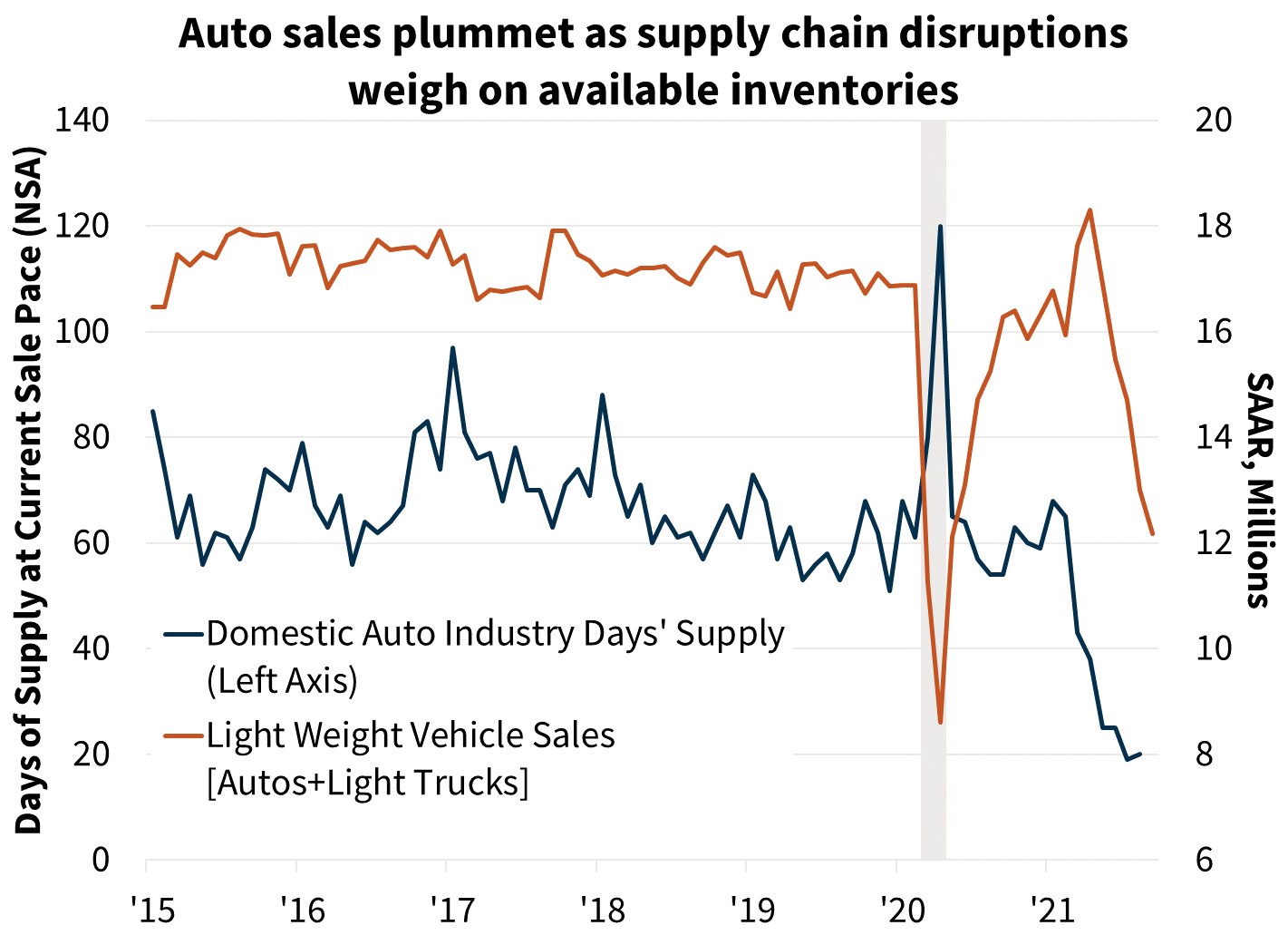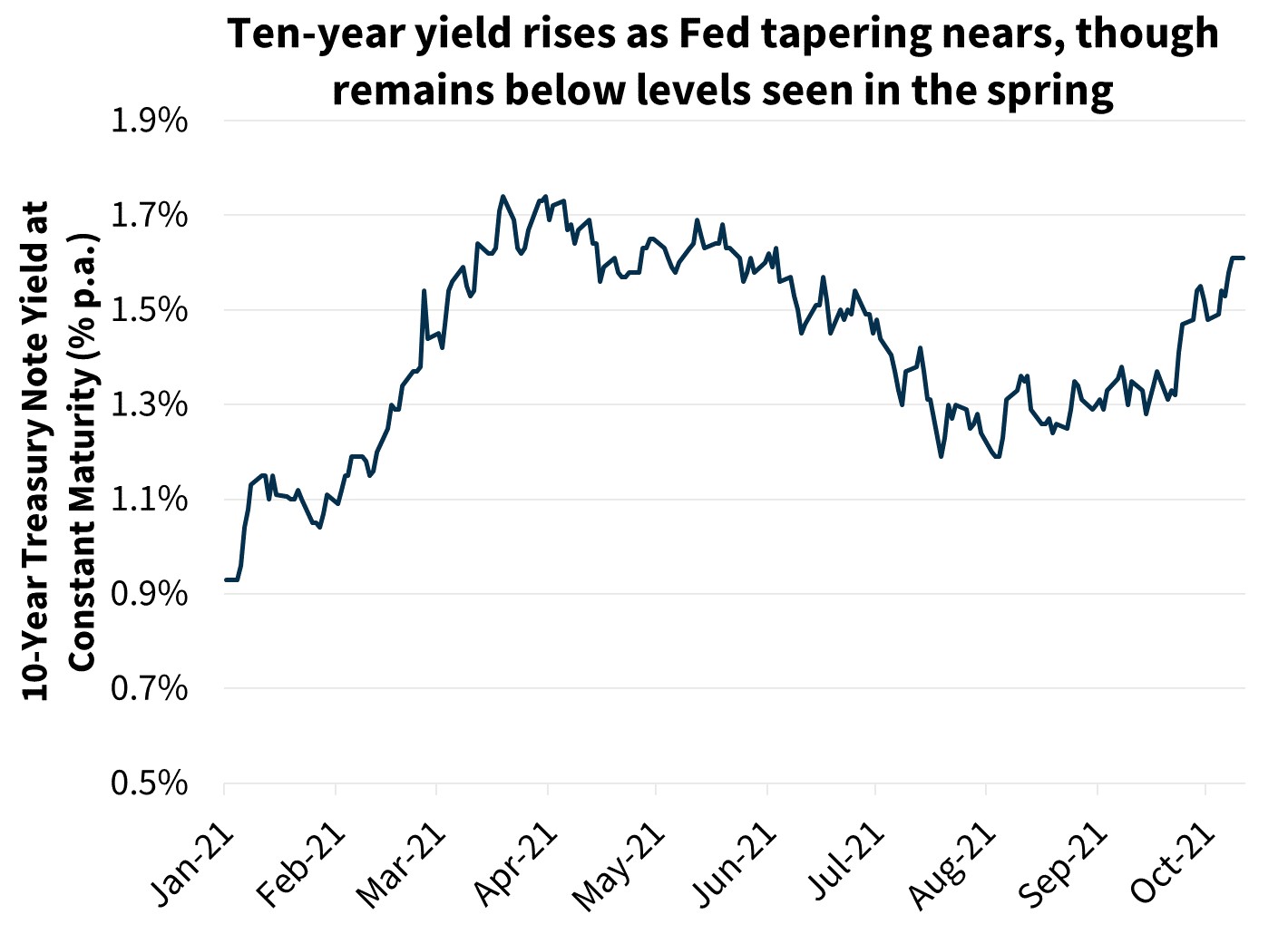Supply Constraints Still Holding Back Housing and GDP
We revised downward our forecast for 2021 real gross domestic product (GDP) growth from 5.4 percent to 4.9 percent on a fourth quarter-over-fourth quarter (Q4/Q4) basis, while the outlook for 2022 was adjusted downward to 3.6 percent from 3.8 percent. The revision was driven by a more pessimistic view regarding the pace of supply chain issues resolving, as well as a related slower expected transition in consumer spending away from goods and toward services. Evidence to date of labor market tightness easing is also scant, while recent global energy shortages have led to a jump in energy prices, likely weighing on consumer sentiment and eating into disposable income. Although these constraints will likely lessen over time, we expect that they will drag on economic activity through next year while inflation pressure compels the Federal Reserve to begin tightening monetary policy. We expect a tapering announcement by the Federal Reserve before year-end, and we now project an interest rate hike to occur in Q4 2022.
Even with a slower growth outlook, we revised upward our inflation forecast. As measured by the Consumer Price Index (CPI), we raised our forecast for 2021 annual year-end inflation to 5.7 percent from 5.4 percent and the Federal Reserve’s preferred measure of inflation, the PCE deflator, to 4.7 percent from 4.6 percent. The upgrade was largely due to higher-than-previously-expected energy prices. We expect a deceleration next year, but anticipate inflation to remain elevated, with the core CPI and PCE measures both remaining above three percent at year-end 2022.
Additionally, we revised upward our quarterly forecast of home price growth. As measured by the FHFA Purchase-Only Index, we now expect 2021 annual house price appreciation to be 16.6 percent, up from 14.8 percent, while our forecast of 2022 home price growth was upgraded by 2.3 percentage points to 7.4 percent. Revisions to the 2022 home sales forecast were modest; however, leading indicators point to near-term existing home sales surprising to the upside. We have therefore revised upward our expectations for 2021 total home sales growth to 4.7 percent from 3.3 percent. We have also adjusted our housing construction forecast such that some of the single-family housing starts that we had previously expected would occur near year-end 2021 are now projected to happen in 2022, while near-term multifamily starts were revised upward on strong incoming data. Regarding mortgage originations, a higher path for house price appreciation was partially offset by a higher mortgage rate forecast. On net, our expectations for 2021 total single-family mortgage market originations were little changed at $4.3 trillion, while our forecast of 2022 originations was revised upward by 2.4 percent; however, after rounding it remains at $3.3 trillion.
The principal risks to our forecast come from the speeds at which global supply chain disruptions are resolved and the continued transition back into services consumption occurs. To what extent labor supply returns to the pre-COVID trend is also a risk to the economy’s output potential. In the short run, further energy price increases could impact growth, inflation, and interest rates. Additionally, we have not yet incorporated any potential fiscal package into our outlook due to uncertainty over details and timing. The key additional risk to our housing forecast is a possible higher-than-expected rise in mortgage rates precipitated by a more persistent increase in inflation expectations.

Energy Prices Come into Focus
Fresh attention has been given to rising energy prices, particularly in Europe and Asia, where natural gas has surged to record highs. While price movement has been less severe in the U.S., natural gas prices recently rose as high as $6.31 per million British thermal unit (BTU), before pulling back to $5.35 as of this writing. The peak was the highest price since 2008 and up more than 200 percent over the past 12 months. Meanwhile, WTI and Brent oil prices recently rose above $80 per barrel, also a first since 2008. A confluence of factors has led to a severe shortage of natural gas through much of Europe, thus putting upward pressure on U.S. prices via increased liquified exports, as well as global oil prices through substitution. U.S. demand for energy has also rebounded faster than production in recent months, leading to a below-average stock of natural gas and near five-year lows in stored petroleum products. Despite these developments, producers have shown a more subdued drilling response to date presumably due to fresh memories of losses in recent years after oil price increases reversed. Increased regulatory scrutiny and growing investor preference for green energy is also likely further limiting investment in new non-OPEC production. Consistent with this thesis, OPEC this month declined to increase output above its previously announced schedule, suggesting it does not consider a ramp-up in non-OPEC production to be a significant near-term risk to its market share or prices. We have therefore updated our underlying assumptions for oil prices over the next couple of years. We had previously expected a convergence to about $65 per barrel by year-end 2022, but we now see prices remaining elevated at around $75. Gasoline prices will contribute about 1.4 percentage points to topline CPI on an annual basis in the fourth quarter, while natural gas and electricity price increases are likely to add about 0.3 percentage points. Higher energy costs will eat into discretionary consumer spending in the coming months and could further dent sentiment. Additionally, energy prices have historically been an outsized driver of inflation expectations. When added to the general upward trend in inflation expectations of the past six months, this risks an “unanchoring” of expectations, which could compel global central banks to tighten policy more swiftly than they had previously planned. Furthermore, given the low levels of inventory currently available, price volatility is more likely in the coming months, especially if a colder-than-normal winter occurs in the Northern Hemisphere, with a temporary oil price spike to over $100 per barrel a possibility.

Supply Constraints Still the Story
The ongoing story of supply disruptions and tight labor markets continued over the month. This is most evident in the new autos market where sales plunged 6.1 percent in October, the fifth straight monthly decline and the slowest pace since May 2020. However, the sales decline is not due to a lack of demand. Ongoing chip shortages are throttling auto production, so auto dealer inventories remain at near-record lows. The positive news is that executives at multiple auto manufacturers have recently described the situation as “stabilizing,” coinciding with a ceasing of further plant shutdowns. However, production is not expected to return to normal until well into next year. We are therefore projecting auto sales and production to hold back personal consumption growth and inventory investment, respectively, through our forecast horizon. However, the period of declines is likely nearing its end. After significantly dragging on Q3 GDP growth, we expect a gradual increase in auto sales and inventory restocking to contribute to growth in 2022.
Part of the difficulty firms are facing generally in rebuilding inventories is the continued above-normal share of consumption consisting of goods rather than services, which is straining supply chains. Services spending is recovering, but the pace has slowed, and it remains well below the pre-COVID trends. Our updated expectation for a slower services spending pace is one of the drivers of our slower growth outlook via less inventory rebuilding, more subdued personal consumption growth, and a higher rate of imports to fulfill goods demand. Additionally, the service spending gap is not evenly spread throughout the service sectors. Many still in recovery are related to travel, hospitality, and entertainment. Even within service categories, the recovery has been asymmetrical. For example, travel activities related to leisure have recovered more than those associated with business. This has disrupted seasonal patterns in the data for both consumption and prices, as evidenced by the August inflation measures, which showed a pullback in prices for hotels and airline tickets as summer leisure travel transitioned into bookings for a still-subdued business travel season. Similarly, we expect spending on services to be comparatively strong over the holiday season with travel-related prices firming – and then softening after December.
September payroll growth of 194,000 employees disappointed as the consensus expectation was above 500,000. However, the details of the report were more mixed than the headline suggested. The prior two months of job gains were revised upward significantly, while odd seasonal patterns around school reopening and hiring likely contributed to the seasonally adjusted decline of 180,000 jobs in education employment. Additionally, the household survey used in calculating the unemployment rate reported a larger gain of 526,000 jobs and a decline in unemployment by 0.4 percentage points to 4.8. While the pace of hiring remains comparatively modest, it is not for the lack of labor demand. Average hourly wages rose by a brisk 0.6 percent over the month, continuing the recent trend of strong gains. On an annualized basis wages were up 6.0 percent over the last six months, almost double the pre-COVID 2019 pace. That employers are facing wage pressures is also supported by business surveys continuing to show near-record levels of firms reporting difficulty filling positions. While stronger nominal wage growth will help maintain household consumption, it also points to growing inflationary pressure as those same business surveys indicate a high share who are raising or planning to raise prices further. While we believe some of the factors leading to limited labor supply are likely to improve going forward, it increasingly appears that labor force participation will not return to the pre-COVID trend in the near term. We expect this to act as a headwind to growth.

Home Prices Revised Upward on Tight Supply
Existing home sales pulled back in August by 2.0 percent, but the decline was less than we had previously forecast. Furthermore, August pending sales, which lead closings on average by about 30-45 days, unexpectedly jumped by 8.1 percent. Combined with some recent strength in mortgage applications data and a reassessment on our part regarding the share of homes purchased without a mortgage, we have meaningfully upgraded our expectation for Q3 and Q4 existing home sales. Still, the supply of new listings continues to follow the 2019 pace for this time of year, while sales remain above the 2019 trend. Listings are therefore not strong enough in our view to sustain the current sales pace and, when combined with a modest increase in mortgage rates, we expect home sales to drift lower next year.
The lack of listings continues to put upward pressure on home prices, as well. While we expect price growth to decelerate next year as affordability constraints weigh on demand and some housing supply is added, we have upgraded our home price forecast by 1.8 points for 2021 and by 2.3 points for 2022, as measured by the FHFA Purchase Only index. The Fannie Mae Home Purchase Sentiment Index® (HPSI) also continues to show respondents indicating an increasing belief that it is a bad time to buy a home, citing high prices as the main driver. When compared to this past spring, housing market activity has cooled, as indicated by measures such as the number of homes with multiple bids, average days on the market, and sales prices relative to asking prices. However, these indicators all remain well above the historical norm and point to a continued tight market. We believe strong price appreciation is likely to continue in coming months. The most recent reading of the CoreLogic National House Price Index for the month of July showed annual appreciation of 19.7 percent, the fastest annual growth rate on record, up from 18.7 percent a month prior.
Higher house prices bode well for new home construction; and ultimately more completed units should help cool prices. However, ongoing supply constraints continue to limit the pace of starts. Single-family starts fell back 2.8 percent in August. However, the total number of single-family homes under construction continued to rise, up 1.6 percent in August to the highest level since mid-2007, although many of these homes are delayed due to bottlenecks as varying materials are in short supply. Recent public comments and anecdotes from homebuilders suggest these problems will not be alleviated in the near term. Additionally, a lack of labor (particularly in the skilled trades) is limiting construction, and the most recent labor report showed only a modest increase in residential construction workers in September. While we expect these issues to alleviate eventually, as is the case with the general economy, these constraints will likely persist well into next year.
While supply constraints continue to affect multifamily construction as well, incoming data continues to impress. The series is notoriously volatile, but multifamily starts jumped 20.6 percent in August to the highest level since January. Multifamily permits have also trended upward. Given continued strong rent increases and very low vacancy rates across most metro regions, we expect there to be ample investor and developer interest in multifamily construction going forward. We have meaningfully upgraded our near-term multifamily starts forecast and expect the full-year 2021 total to be 21.7 percent higher than in 2020, up from a previous forecast of 17.6 percent growth.
For more on multifamily market conditions please see the October 2021 Multifamily Market Commentary.

Interest Rates Beginning to Move Upward as Tapering Nears
Despite the weak September labor report headline, we expect a tapering of asset purchases to be announced at the Federal Reserve’s November meeting. Furthermore, given both our outlook for inflation through 2022, as well as FOMC Chairman Jerome Powell’s statement that tapering would likely be completed by the middle of 2022, we now also expect the Fed to hike the federal funds rate by 25 basis points in the fourth quarter of 2022.
The 10-year Treasury rate has moved up recently from around 1.3 percent following the Federal Reserve’s September meeting to around 1.6 percent as of this writing. We forecast it to average 1.7 percent in 2022, an increase of two-tenths from September. Similarly, mortgage rates also recently increased, with the average rate on a 30-year fixed-rate mortgage rising as high as 3.01 percent the week of September 30, the highest since June. We now forecast mortgage rates to average 3.3 percent in 2022, an increase of two-tenths from our previous forecast. While still modest by historical standards, given rapid house price appreciation, upward movement in mortgage rates is likely to lead to increasing affordability constraints, which should help dampen next year’s house price growth compared to the torrid pace of this past year.
This month we updated our historical estimate of 2020 single-family mortgage originations due to our annual benchmarking to recently released Home Mortgage Disclosure Act (HMDA) data. This resulted in a minor downward revision to estimated 2020 total origination volumes, with our 2020 estimate now at $4.4 trillion, down $162 billion from our previous estimate. Purchase originations are estimated to be $1.6 trillion and refinance originations $2.8 trillion, down $74 billion and $88 billion, respectively.
Going forward, due primarily to a stronger house price outlook, we revised upward our forecast for single-family purchase mortgage originations by $25 billion, or 1.4 percent, in 2021 and by $71 billion, or 3.6 percent, in 2022. Purchase volumes are now expected to grow 18 percent in 2021 to $1.9 trillion. However, we expect purchase volume growth to decelerate in 2022, to a lesser 9 percent pace over 2021, as rising home prices are somewhat countered by our expectation of slowing sales. In part due to the HMDA benchmarking leading to different base effects, we revised slightly downward our projected 2021 refinance volumes by $31 billion to a total of $2.5 trillion. Although refinance demand is expected to fall next year – due in part to upwardly drifting rates – originations are expected to remain above pre-pandemic levels with continued home price strength and moderate rate levels. We expect refinance volumes to fall to $1.3 trillion in 2022, down 46.7 percent from a heightened 2021 level. At the current mortgage rate of 2.99 percent, we estimate that approximately 45 percent of outstanding mortgage loans have at least a 50-basis point incentive to refinance.
Economic & Strategic Research (ESR) Group
October 12, 2021
For a snapshot of macroeconomic and housing data between the monthly forecasts, please read ESR’s Economic and Housing Weekly Notes.
Data sources for charts: Bureau of Economic Analysis, Ward’s, Energy Information Administration, Bureau of Labor Statistics, National Association of REALTORS®, Federal Reserve, Fannie Mae ESR Analysis.
Opinions, analyses, estimates, forecasts and other views of Fannie Mae's Economic & Strategic Research (ESR) Group included in these materials should not be construed as indicating Fannie Mae's business prospects or expected results, are based on a number of assumptions, and are subject to change without notice. How this information affects Fannie Mae will depend on many factors. Although the ESR group bases its opinions, analyses, estimates, forecasts and other views on information it considers reliable, it does not guarantee that the information provided in these materials is accurate, current or suitable for any particular purpose. Changes in the assumptions or the information underlying these views could produce materially different results. The analyses, opinions, estimates, forecasts and other views published by the ESR group represent the views of that group as of the date indicated and do not necessarily represent the views of Fannie Mae or its management.
ESR Macroeconomic Forecast Team
- Doug Duncan, SVP and Chief Economist
- Mark Palim, VP and Deputy Chief Economist
- Eric Brescia, Economics Manager
- Nick Embrey, Economist
- Nathaniel Drake, Economic Analyst
- Richard Goyette, Economic Analyst
- Rebekah Gutierrez, Financial Analyst
